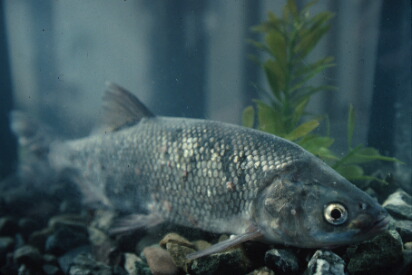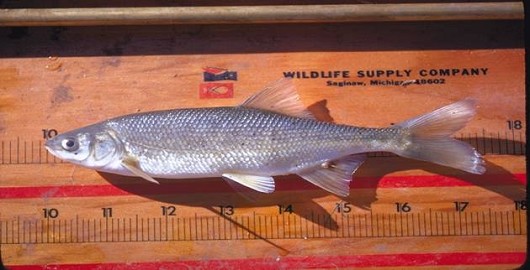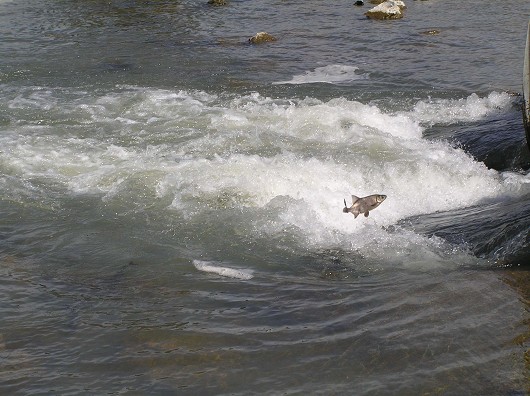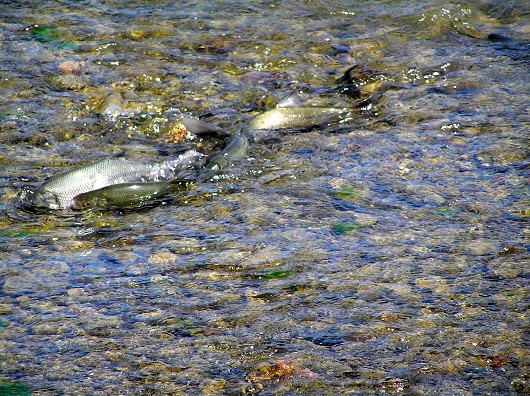Hitch
-
Scientific NameLavinia exilicauda
-
NativeNative Species
-
Identification
 Hitch. Photo by Richard Macedo, California Department of Fish and Game.
Hitch. Photo by Richard Macedo, California Department of Fish and Game. Hitch adult. Photo courtesy of Professor Peter B. Moyle.
Hitch adult. Photo courtesy of Professor Peter B. Moyle.- Deep, laterally compressed body, may exceed 35 cm SL
- Large scales, small head, upturned mouth
- Narrow caudal peduncle, large anal fin, large forked tail, keel absent
- Brownish yellow back, no spot, progressively darker with age
- Juveniles: silvery, possess spot
- Fin rays: anal 11-14, dorsal 10-13
- Lateral line scales: 54-62 (decurved)
-
Life History
Hitch are most often found in slow warm water, including lakes and quiet stretches of rivers. Hitch are sometimes found in cool and clear, low-gradient streams, hiding among aquatic vegetation in sandy runs or pools. They are the most heat tolerant of the native Central Valley fishes and can withstand water temperatures greater than 30°C under some conditions. They have also been found living in brackish water with salinities as high as 9 ppt. Within a pristine system hitch often share habitat with Sacramento blackfish, Sacramento suckers, and Sacramento pikeminnows. In altered systems hitch are found among introduced species like mosquitofish, catfish, and centrarchids. In a stream the hitch may use its upturned mouth to feed in the water column or to feed on the surface for insects. In a lake hitch may occupy different spaces depending upon age. Juveniles typically live in shallow vegetated areas near shore, while the older fish (>80 days) live in deeper offshore waters. Young hitch may shoal for the first two months of residency in a lake. The diet of a limnetic (lake-dwelling) hitch may include zooplankton, crustaceans, or various forms of insects. Growth rates of hitch vary depending upon the environmental conditions, though in general females reach sexual maturity in 2-3 years, while males may reach sexual maturity in years 1-3. Spawning typically happens in the tributaries to lakes and rivers, and may begin as early as February and end as late as July. Fecundity in hitch is relatively high as one female may produce 3,000 to 63,000 eggs, depending upon body size. When spawning adults reach a suitable riffle for breeding one female may be surrounded by 1-5 males. A ripe female releases her eggs into the current and the males immediately fertilize the eggs. The eggs then settle into the gravel substrate where the size of the ova will increase and help lodge it into the rock particles. In 3-7 days the embryos hatch, and 3-4 days after the hatch the embryos begin to swim freely. The young hitch may swim downstream to a lake or slough, or reside within the stream under the cover of aquatic plants. Hitch generally live for a total of 4-6 years.
 Hitch jumping at Bell Hill Road Crossing on Adobe Creek (Clear Lake, CA) on 4/21/2006. Photo by Richard Macedo, California Department of Fish and Game.
Hitch jumping at Bell Hill Road Crossing on Adobe Creek (Clear Lake, CA) on 4/21/2006. Photo by Richard Macedo, California Department of Fish and Game. Hitch spawning at Bell Hill Road Crossing on Adobe Creek (Clear Lake, CA) on 4/21/2006. Photo by Richard Macedo, California Department of Fish and Game.
Hitch spawning at Bell Hill Road Crossing on Adobe Creek (Clear Lake, CA) on 4/21/2006. Photo by Richard Macedo, California Department of Fish and Game.Videos of Clear Lake hitch spawning:
Hitch (Clear Lake hitch) spawning in Kelsey Creek, a tributary of Clear Lake. Filmed 03/26/08 by Lisa Thompson. Thanks to Peter Windrem (Chi Council for the Clear Lake Hitch) for showing me the fish!
Hitch (Clear Lake hitch) spawning in Kelsey Creek, a tributary of Clear Lake. Single fish swimming along shore. Filmed 03/26/08 by Lisa Thompson. Thanks to Peter Windrem (Chi Council for the Clear Lake Hitch) for showing me the fish!
-
Links to Other Research
Clear Lake Annotated Bibliography
August 29, 2011
By Kristina L. Weber, Lisa C. Thompson, Gregory A. Giusti, and Ryan F. Keiffer
University of California Cooperative Extension
Wildlife, Fish, and Conservation Biology Department
UC Davis, 1 Shields Ave, Davis, CA 95616
Contact: lcthompson@ucdavis.edu
This bibliography contains 302 references, including journal articles, books, reports, newspaper articles, and videos. The main focus was on fish, particularly Clear Lake hitch and largemouth bass, but there are also references on culture, settlement, mining, and lake water chemistry. Items are listed in alphabetical order by author, beginning with anonymous works (no author listed).
The bibliography is available for download as a pdf file:
Clear Lake Annotated Bibliography (pdf file)
and as an html link:
Clear Lake Annotated Bibliography (html file)
A version of this bibliography is also available in EndNote, at no cost. Please contact Lisa Thompson at lcthompson@ucdavis.edu to obtain a copy.
-
Watershed
-
Alisal-Elkhorn Sloughs Watershed
-
Carmel Watershed
-
Coyote Watershed
-
Honcut Headwaters Watershed
-
Lower American Watershed
-
Lower Bear Watershed
-
Lower Butte
-
Lower Cache Watershed
-
Lower Calaveras-Mormon Slough Watershed
-
Lower Cosumnes-Lower Mokelumne Watershed
-
Lower Feather Watershed
-
Lower Sacramento Watershed
-
Lower Yuba Watershed
-
Middle Fork Feather Watershed
-
Middle San Joaquin-Lower Chowchilla Watershed
-
Middle San Joaquin-Lower Merced-Lower Stanislaus Watershed
-
Mill Watershed
-
Pajaro Watershed
-
Russian Watershed
-
Sacramento-Lower Thomes Watershed
-
Sacramento-Stone Corral Watershed
-
Salinas Watershed
-
San Francisco Bay Watershed
-
San Joaquin Delta Watershed
-
San Pablo Bay Watershed
-
Suisun Bay Watershed
-
Tulare-Buena Vista Lakes Watershed
-
Upper Cache Watershed
-
Upper Calaveras Watershed
-
Upper Chowchilla-Upper Fresno Watershed
-
Upper Cosumnes Watershed
-
Upper Deer-Upper White Watershed
-
Upper Dry Watershed
-
Upper Kaweah Watershed
-
Upper King Watershed
-
Upper Merced Watershed
-
Upper Mokelumne Watershed
-
Upper Putah Watershed
-
Upper San Joaquin Watershed
-
Upper Stanislaus Watershed
-
Upper Stony Watershed
-
Upper Tule Watershed
-
Upper Tuolumne Watershed
-
Upper Yuba Watershed
-
Please note, watersheds are at the USGS 8-digit Hydrologic Unit Code (HUC) scale, so they often include a lot of sub-watersheds. If a species occurs in any sub-watershed within the HUC, the species appears within the HUC. Link to an EPA page that shows HUCs.



